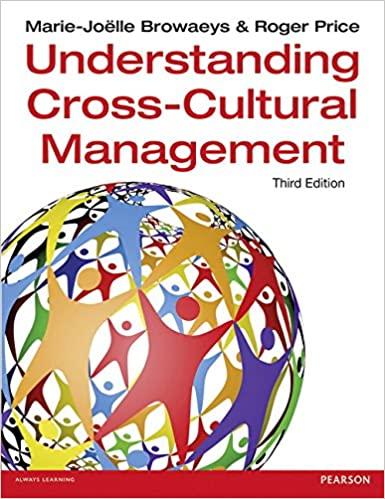In 2001, Michelin, the worlds leading tyre manufacturer and based in France, set up a joint venture
Question:
In 2001, Michelin, the world’s leading tyre manufacturer and based in France, set up a joint venture in Shanghai, China, with Shanghai Tyre and Rubber Company. The Chinese tyre market was expected to almost treble within three years, so Michelin was happy to invest $200 million in the company.
The new company, in which Michelin had a 70 per cent stake, was mostly made up of employees from the Chinese partner plus a small team of expatriate managers and managers recruited from other international ventures in China. The expatriates were used to lay the foundation for future operations and to support the management team that had originally run the Chinese company. This team was kept in place to facilitate the integration process.
Michelin wished to implement its well-established personal management philosophy in the new company.
This was the way to develop the personal and professional effectiveness of the workforce as well as help individuals develop their career in the company. The company badly needed managers who could work in a joint venture environment, so this active approach to human resource development compensated for the dearth of suitable managers available in China.
The management approach Michelin wished to have adopted was based on Michelin’s five core values which were founded on respect for: customers, people, shareholders, the environment and facts. See the company’s corporate website: http://www.michelin.com/corporate/front/templates/affich.jsp?codeRubrique =74&lang=EN .
These values were immediately recognisable and not difficult for the Chinese employees to accept. But were they aware of what the implementation of these values through the management approach entailed?
The personnel department in Shanghai, as well as its counterparts in other Michelin production plants, was responsible for creating and maintaining a strong, open and shared company culture, one that was a source of social cohesion and motivation. The department encouraged individual employees to advance themselves professionally according to their performance, skills and ambitions. Just as on other Michelin sites, the department was set apart from the business units. The personnel managers had no formal position in the hierarchy but worked closely with partners, the managers of the business units. During the employees’ progress within the company there was continual evaluation and face-to-face dialogue involving the employee, the unit manager and the career manager from the personnel department.
In her analysis of the personnel situation in the Shanghai plant, the human resources director of Michelin China described the difficulties that the integration of this approach into the joint venture would cause (Qi, 2005). Clearly, this could not be done overnight. The concept of appraisal and the role of career managers did not fit into the concept that the Chinese have of management and the importance given to hierarchical relationships. Other elements of the HR approach that would be difficult for the Chinese to accept included the notion that support functions such as human resources were as important as functional departments and the expectation that employees should speak openly about themselves and the working environment.
The starting point of any integration needed to be for both sides to understand each other’s ways of thinking. In this way initial fears and suspicions could be removed and the process of building mutual trust set in motion. The employees who had been recruited from other joint ventures and who had become familiar with Western practices acted as a bridge between the expatriates (who were mostly involved in the technical process) and the line managers (who were Chinese). In addition, considerable resources were dedicated to training courses and study abroad for (potential) managers.
Four years after the creation of the joint venture, the HR director saw some progress, but that integration was by no means complete. Although some employees were unable to adapt to the changing environment and left, the majority appeared to be willing to accept Michelin’s approach to human resources. The career management system was ‘taking shape’ and the process of dialogue between employees, career managers and line managers was under way. At the same time, the expatriates had gained a deeper insight into how the Chinese culture works.
As the writer indicates, one core value of the Michelin culture – respect for people – lies at the core of the integration process. Respect by both sides of both sides. The process, therefore, was not about establishing the Michelin way, or the Chinese way; it was about establishing the Michelin China way.
Questions
1. Summarise what you believe to be the ‘Michelin China way’.
2. Which of the values, as described in the competing values framework, do you recognise in the case with regard to Michelin and its Chinese partner? How do you account for any similarities or differences?
Step by Step Answer:

Understanding Cross Cultural Management
ISBN: 9781292015897
3rd Edition
Authors: Marie Joelle Browaeys, Roger Price





